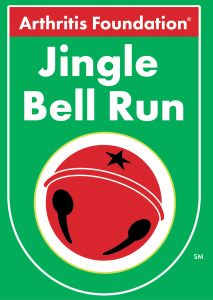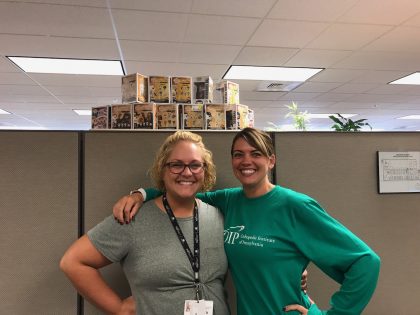Dr. Oliverio on WIP CBS Philadelphia
Our very own, Dr. James Oliverio, was the expert speaker on WIP CBS Philly NovaCare Injury Podcast talking about Carson Wentz and ACL tears!
If you experience issues listening to the Podcast, please visit http://philadelphia.cbslocal.com/novacare-2/ (NovaCare 1/2/2018)
Dr. James Oliverio is a board-certified orthopedic surgeon and partner in the Orthopedic Institute of Pennsylvania (OIP), central Pennsylvania’s largest and most respected orthopedic practice.
Dr. Oliverio specializes in the surgical management of sports-related injuries, musculoskeletal trauma, and joint replacement surgery.
Dr. Oliverio provides care for athletes in the greater Harrisburg region of central PA.
Learn more about Dr. Oliverio here.
Good Day PA- Dr. Frank
Dr. Frank featured on ABC27 Good Day PA
On December 19th, Dr. Frank, who has a special interest in sports medicine, acupuncture, and non-operation orthopedics, spoke with Good Day PA on behalf of OIP to share awareness of his practice, and what OIP has to offer their patients. Check out the video below:
In Dr. Frank’s segment, he shares how there are over 30 medical providers that treat all types of muscle and bone ailments who work for OIP. There are also conditions that can be treated surgically or non- surgically, which is what Dr. Frank specializes in.
OIP takes pride in the fact that most of their providers are local. They have either gone to high schools in the area, moved away to attend college, and do their residencies, and then come back to Central PA to raise their families and give back to their communities by providing orthopedic care.
Dr. Frank speaks on behalf of OIP and how we are the primary care provider for local high school sports teams and our semi-pro teams in the area as well.
Dr. Frank graduated from St. George’s University School of Medicine, after he was named Chief Resident during his residency in Family Medicine at South Nassau Communities Hospital. Upon completing his residency in Family Medicine, he worked in a Public Health Service clinic/ hospital in Barrow, Alaska. He then volunteered through Americares in Kauai, Hawaii, at a clinic in need after Hurricane Iniki. He then spent time cruising the seas as the ship’s doctor on several cruise ships as well as working in a variety of emergency rooms. He later landed in Central PA to obtain and complete his Primary Care Sports Medicine fellowship at a Penn State / Hershey Medical Center / PinnacleHealth program.
Dr. Frank is licensed in acupuncture and has training in Mind-Body Medicine. He has extensive experience in occupational medicine, sports medicine, and complementary medicine. He was the medical director of Pinnacle Health Complementary medicine center, WellQuest, during the entirety of its existence. He has always thought the best type of medical practice should include surgical and non-surgical options for musculoskeletal injuries. He is pleased to be part of that great mission at OIP.
Learn more about Dr. Frank here.
Dr. Frank’s December 19th segment is featured on the ABC27 Good Day PA site here.
ABC27 Always On
ABC27 Always On streams all newscasts live, as well as Good Day PA! at 12:30 p.m. weekdays.
2017 Jingle Bell Run – Harrisburg
Be part of the longest-standing, holiday-themed 5K race series anywhere – and fight with us to conquer arthritis!
Register today to join our team and help us fight arthritis pain.
The Orthopedic Institute of Pennsylvania has joined forces with the Arthritis Foundation this holiday season! We are forming a team, raising funds, and running or walking in the Annual Jingle Bell Run/Walk for Arthritis.
This years Jingle Bell Run/Walk will be held at the UPMC Pinnacle West Shore Hospital on Saturday, December 9, 2017 (12/9/2017). Registration will begin at 7:00 AM and the 5K Run/Walk begins promptly at 10:00 AM.
The Arthritis Foundations Jingle Bell Run/Walk continues to be chosen as one of the Most Incredible Themed Races. The Jingle Bell Run/Walk for Arthritis is a fun and festive way to kick off your holidays by helping others!
Wear a holiday themed costume. Tie jingle bells to your shoelaces. Raise funds to help find a cure for arthritis, the nation’s leading cause of disability. Run or walk a 5 kilometer route with your team members and celebrate the season by giving. Be a Champion of Yes! 100 percent of your registration fee and fundraising efforts go to this great cause.
Register today to join our team and help us reach our Team Goal of $5,000 and fight arthritis pain.
How to register: Left click on the red “Join Team” button on the right-hand column above our goal amount. Review the Waiver/Agreement and click on “I Agree”, Login to your previous account or register for a new one. Register Today!
Discount Offer – Save $5 on your registration!
Save $5 on your Jingle Bell Run/Walk 5K registration by using discount code: “OrthoPAJBR”.
How to donate: Left click on the blue “Donate Now” button on the right hand column above our goal amount. Enter the amount you would like to donate, click on “Donate” and complete the Donor Information form. Donate today!
To Join Our Team or to Donate to the Arthritis Foundation, please visit http://www.jbr.org/harrisburg/TeamOIP.
For more help or information about the 2017 Jingle Bell Run of Harrisburg, contact Brendan Demmy at the Arthritis Foundation by email (bdemmy@arthritis.org) or call (717-884-7523).
18th Annual Cumberland County 50 Plus Expo
OIP is a supporting sponsor and exhibitor at the upcoming 18th Annual Cumberland County 50 Plus Expo.
The event will be held on Thursday, October 19th from 9am to 2pm at the Carlisle Expo Center (100 K Street, Carlisle, PA 17013).
Please stop by our booth (193-195) and say “hi!”
Free Health Screening: We will be providing FREE Heel Scans for Bone Density.
Door Prize: Be sure to register for a chance to win our door prize!
50plus EXPOs are lively, FREE one-day events that bring businesses and the community together on a more personal level. For more information, go to www.50plusExpoPA.com.
Thanks for Participating in the 10th Annual Zero Prostate Cancer Run/Walk
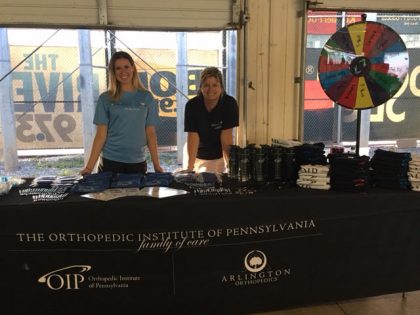
OIP would like to thank everyone who participated in the 10th Annual Zero Prostate Cancer Run/Walk that was held on Friday, September 22nd!
This event was held on City Island in Harrisburg and featured a 5K run/walk, 1-mile walk, Kids’ Superhero Dash for Dad, and virtual Snooze for Dudes program.
To donate, please visit http://support.zerocancer.org/site/TR?fr_id=1355&pg=entry
Osteoporosis Clinic
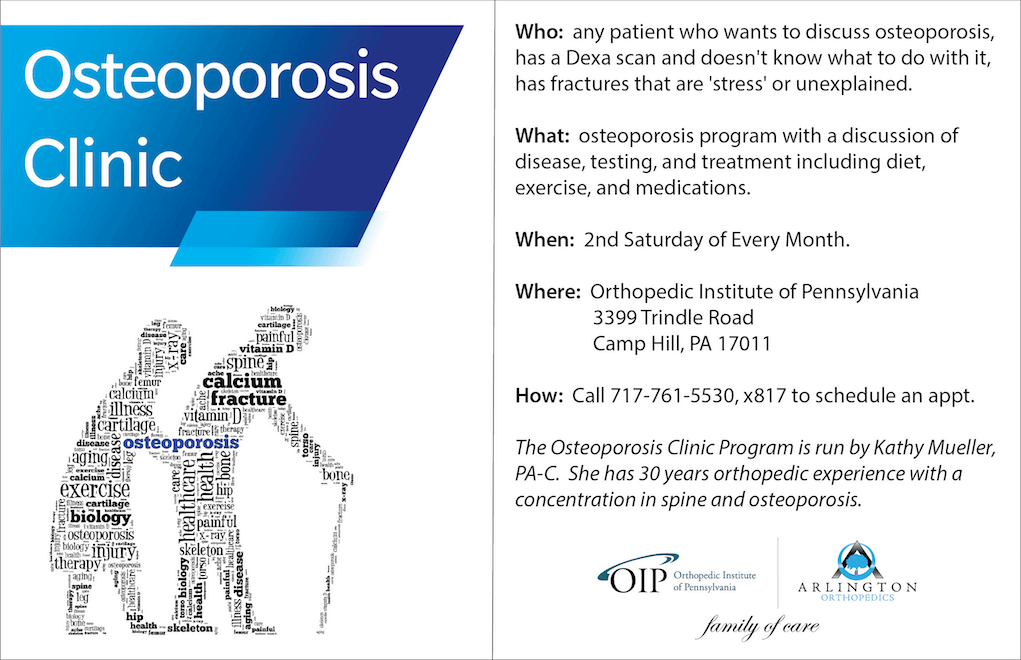
OIP offers an Osteoporosis Clinic the 2nd Saturday of every month to any patient who wants to discuss osteoporosis, have a Dexa scan and doesn’t know what to do with it, has fractures that are ‘stress’ or unexplained.
Kathy Mueller, PA-C, runs the Osteoporosis Clinic program. She has 30 years of orthopedic experience, with a concentration in spine and osteoporosis. Her program includes discussion of disease, testing, treatment plans including diet, exercise, and medications.
To schedule an appointment, please contact Kathy Mueller’s assistant at 717-761-5530, x817.
Simply The Best – Medical Specialist Award 2017

National MDA Awareness Month
August is National MDA Awareness Month!
The providers and staff at OIP are raising awareness and showing their support by having a Jeans & Green fundraiser. All donations are being directed to The Muscular Dystrophy Association (MDA).
The Muscular Dystrophy Association (MDA) is leading the fight to free individuals and their families who love and support them from the harm of muscular dystrophy, ALS and related muscle-debilitating diseases that take away physical strength, independence, and life.
Please join us in support of National MDA Awareness Month by learning more and donating to this amazing organization by visiting https://www.mda.org
OIP Safe Summer Fun Series: Football
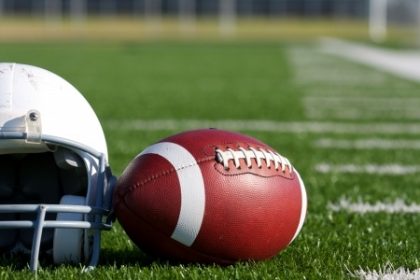
OIP Safe Summer Fun Series: Football
- Equipment is a big deal! Players must wear a helmet, pads (shoulder, hip, tail, knee), pants, thigh guards, jersey, mouth guard with strap, athletic supporter, proper shoes, and safety glasses or contacts, if needed.
- Coaches need to have basic skills when it comes to treating scrapes, cuts, and bruises, and they need to have a way to reach emergency personnel if the need arises.
- If a player is returning after an injury, they need to be cleared by a physician. This means that they have been evaluated and have no residual tenderness, inflammation, motion issues, or decreased strength in the affected area. When it comes to concussions, it is advisable to have exams by a doctor specializing in head injuries.
- Players should be active in the off-season as well. This will make it easier to adjust to the demands of the season.
- Hydration is very important during practice and play.
- Parents and coaches need to be mindful of pain behaviors in children as well as teach the players to raise any concerns right away. If there seems to be an issue, back off or modify the activity to decrease risks.
Simply The Best – Medical Specialist 2017

Simply The Best – Medical Specialist 2017



